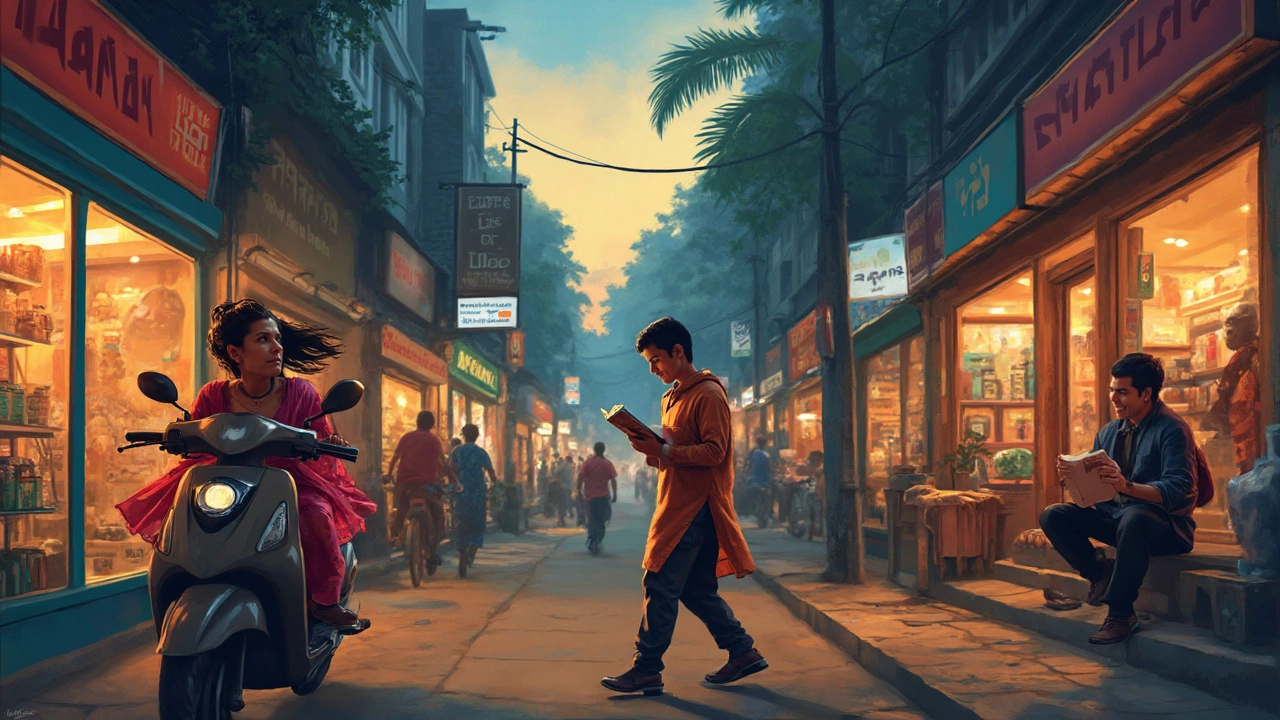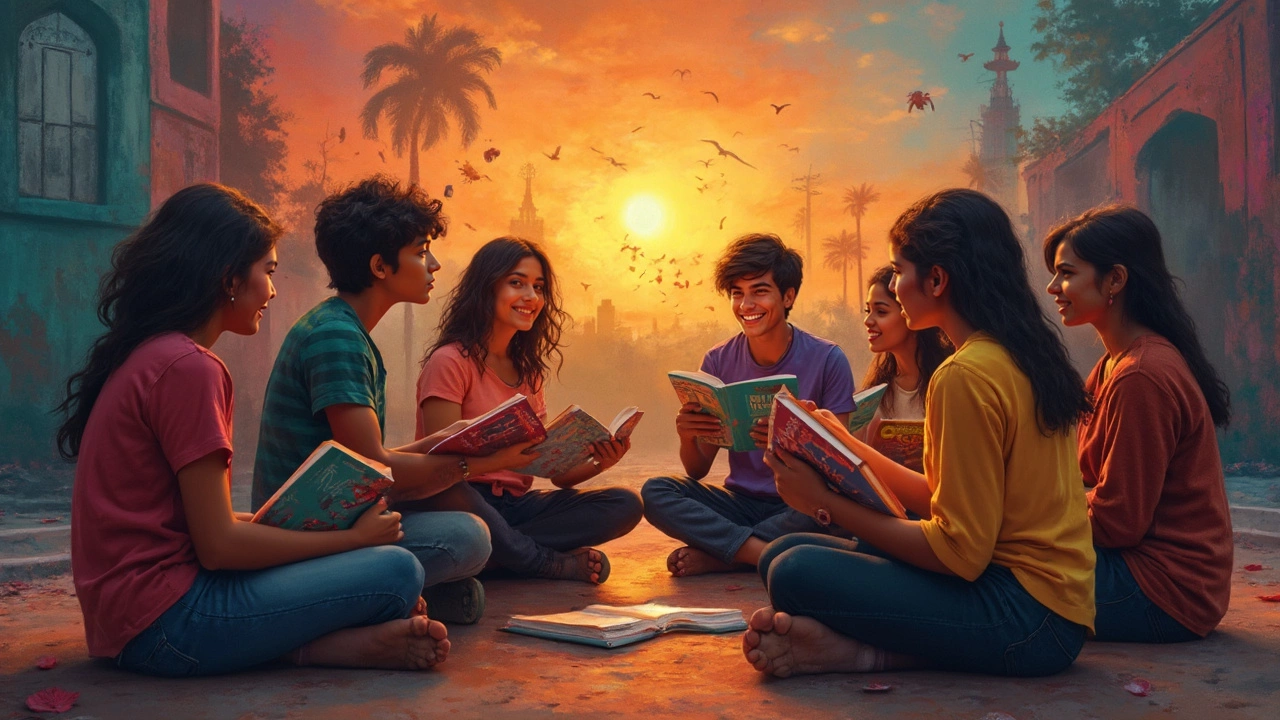If you think young adult fiction is just high school drama and love triangles, you're missing out on a whole lot more. YA fiction is about telling stories through the eyes of people just figuring out life, and that's way messier—and realer—than it sounds.
The age of the main characters often falls somewhere between 12 and 18. But don't get hung up on birthdays—the rules here bend a lot. Sure, you might spot first jobs, early crushes, and fights with parents, but the real heart of YA is the feeling that everything matters on a gut level. That sense of urgency isn’t just for teens. Tons of adults find themselves hooked by stories with high stakes, raw emotions, and big questions.
One thing you’ll notice? YA fiction doesn’t sugarcoat stuff. Topics like mental health, identity, belonging, and even tough stuff like loss or addiction show up all the time. And the best YA books don’t talk down to readers. They trust you can handle it, even if things get uncomfortable or complicated. That’s a big reason the genre’s exploded in the past decade: it respects the reader’s intelligence and emotional range.
- Age Matters... But It's Not Everything
- Themes That Hit Home
- Voice and Perspective
- Breaking the Rules (and Why It Works)
- Tips for Readers and Writers
Age Matters... But It's Not Everything
People toss around the idea that young adult fiction is just for readers in their teens or for stories about teenagers. That's only half right. Most young adult fiction centers on characters between 12 and 18, but what actually matters more is what the characters are dealing with—not just how old they are.
You’ll find that the real action in YA books usually starts when someone takes on something for the first time—first heartbreak, first real risk, first time their world feels too small. These milestones show up because those years are packed with transitions. YA stories get personal about growing up, with no safety net.
But here’s the twist: a lot of YA readers are way past high school. The industry even has a term for these fans—“crossover readers”—and they make up right around 50% of YA book buyers, according to Nielsen reports from the last few years. Adults are drawn to the genre’s pace and honesty, not just nostalgia.
Plots in YA usually center on the main character’s discovery of who they are and where they fit, which is why you can have a fantasy with dragons right beside a raw, down-to-earth story about foster care. It’s less about age and more about change. That’s why you’ll see everything from 'The Hunger Games,' where Katniss faces survival and government control, to 'Eleanor & Park,' a grounded story about first love and family struggles—all sitting on the same shelf.
If you’re writing or reading YA, take this as a tip: Worry less about making everything exactly age-accurate. Focus on what feels real to someone taking big leaps—whether that’s starting a band, moving across the world, or just surviving a tough year at school. Those moments are what put the YA in YA.
Themes That Hit Home
Young adult fiction is famous for diving into topics that feel way too real. The stories don’t just skim the surface—they go all-in on stuff teens and even adults actually wrestle with. It’s not just about crushes and popularity; it’s about identity, family pressure, feeling like an outsider, mental health, and tons more. If you’ve ever read a YA book and thought, “Whoa, that’s exactly how I felt,” you’re definitely not alone.
The young adult fiction shelf is stacked with books that tackle the “big stuff.” For example, “The Hate U Give” by Angie Thomas shines a bright light on racism and police violence, while “Eleanor & Park” by Rainbow Rowell digs deep into first love and how home life can shake you up. Then you’ve got stories like “They Both Die at the End” by Adam Silvera—facing mortality isn’t something you expect teenagers to deal with, but YA proves otherwise.
Here are some themes you’ll see coming up again and again:
- Identity and Self-Discovery: Figuring out who you are, whether it’s about gender, sexuality, culture, or something else.
- Mental Health: Anxiety, depression, trauma, and resilience aren’t hidden under the surface—they’re in the front seat.
- Belonging and Friendship: Who you fit in with, fake friends, real connections, and feeling left out.
- Family Issues: Divorce, loss, squabbles, and the stress of trying to live up to expectations.
- Romance and Firsts: Crushes, heartbreaks, awkward beginnings, and lessons that stick with you.
- Social Justice and Activism: YA fiction is never shy about showing teens fighting for change—think climate, race, LGBTQ+ rights, and more.
YA authors aren’t scared of hard truths. In fact, about 41% of YA books published between 2010 and 2020 dealt with difficult social issues, according to a Publisher's Weekly review. That openness is a huge reason the genre keeps growing: readers want honesty, and YA doesn’t flinch.
| Theme | Recent Popular Books |
|---|---|
| Identity & Self-Discovery | "Simon vs. the Homo Sapiens Agenda" |
| Mental Health | "Turtles All the Way Down" |
| Social Justice | "The Hate U Give" |
| Family Issues | "Eleanor & Park" |
| Romance | "To All the Boys I’ve Loved Before" |
If you’re picking up a YA book, expect it to go there—whatever “there” is. The stories stick with you because they pull right from real life, sometimes way too close for comfort, and that’s what makes them so powerful.

Voice and Perspective
The way a story sounds and who tells it is what really makes young adult fiction stand out. Most YA books are told straight from the main character's point of view, and it’s almost always first-person or close third-person. That means you’re not just reading about a teenager—you’re practically inside their head, feeling every awkward moment and big win right along with them.
Here’s the thing: YA voice is fast, honest, and usually pulls zero punches. If a character is frustrated, they don’t hold back. Authors use slang, sarcasm, or even texting language—whatever fits how teens actually talk today. This makes the story believable and way more personal. Leigh Bardugo’s "Shadow and Bone," for example, feels completely real thanks to Alina’s direct, sometimes self-doubting voice. Angie Thomas’ "The Hate U Give" grips you because Starr’s thoughts and reactions feel raw and uncensored.
Studies from publishers show first-person is used in about 60% of YA books released in the last few years. Why? It works. Readers get an unfiltered look at choices and mistakes, and that helps you root for the main character, even if they mess up.
| Point of View | Usage in YA Books (%) | Effect |
|---|---|---|
| First-person | 60 | Feels direct and personal |
| Close Third-person | 30 | Still intimate, just less in-your-face |
| Other (omniscient, etc.) | 10 | Distant, used rarely |
If you’re writing YA, think like your character. Don’t throw in fancy words they’d never use. If you’re reading, look for books with a voice that makes you forget you’re not actually that character. Chances are, you’ll connect with stories that feel real, flaws and all.
Breaking the Rules (and Why It Works)
No other category bends the rulebook quite like young adult fiction. YA authors love to jump between genres, twist storytelling formats, and toss out the so-called “rules” that other books play by. Ever read a book told completely through text messages, diary entries, or podcasts? That’s YA doing its thing. Take Angie Thomas’s “The Hate U Give”—it tackles racism head-on from a teen’s viewpoint, mixes teen slang with heavy issues, and never lets up on honesty.
YA books often mess with story structure, too. Some go for dual timelines or jump between different narrators. “Eleanor & Park” by Rainbow Rowell flips between two leads with wildly different voices, letting readers see both sides of the story. And fantasy or sci-fi YA? Authors blend magic with real-world problems without batting an eye, like in “Six of Crows” or “Scythe.” The boundaries between realistic fiction, romance, and dystopia blur to the point where you can’t always stick a neat label on a book.
Why does this work? YA readers crave stories that feel real—even when they’re outlandish. Following weird rules or old-school formats just doesn’t cut it. When books experiment or take risks, readers stay curious and connected. They get that sense of, "Hey, this could really happen," or, "That character actually sounds like someone I know." The unpredictability keeps things from getting stale, and lets new writers bring in fresh voices.
If you’re thinking about writing YA, don’t be afraid to try something different. Start a chapter with a social media post. Let your main character tell the story out of order. As long as your characters feel honest and the story pulls readers in, you’re on the right track.

Tips for Readers and Writers
Diving into young adult fiction isn’t just about picking up any book on the shelf. Knowing what sets this genre apart can help you spot a great read, or write one that really grabs people.
If you're a reader, take note:
- Don’t skip the tough topics. YA books feature real problems and don’t shy away from things like anxiety, bullying, or family struggles. These stories help you see the world from different perspectives, and sometimes they just make you feel less alone.
- Mix up your genres. Think YA is just romance? There’s also fantasy (think "Six of Crows"), sci-fi ("The Hunger Games"), and mystery. Explore different types and you’ll find surprises where you least expect them.
- Watch for trends, but don’t chase them blindly. If you see a book topping bestseller lists, it’s probably connecting because it feels authentic—not just because it ticks trendy boxes.
Writers, pay attention:
- Get the voice right. The biggest complaint from YA readers is "it doesn’t sound real". Teens today are laser-sharp about spotting fake or cringey dialogue. Eavesdrop in a coffee shop or scroll through TikTok for how teens actually talk.
- Give your characters real stakes. What happens matters. Decisions in YA aren’t light—they’re life-changing (or at least they feel that way). Your story should reflect that urgency.
- Respect your audience’s smarts. Don’t write down to teen readers. They catch lazy writing and cheesy twists instantly. If you’re stuck, grab a popular YA (like "The Hate U Give" by Angie Thomas) and study how the author handles real-life issues with zero sugarcoating.
Here’s a quick look at YA’s current popularity, based on U.S. publishing data from 2023:
| Year | YA Titles Published | YA Sales (Millions) |
|---|---|---|
| 2016 | 4,700 | 70 |
| 2020 | 5,300 | 83 |
| 2023 | 6,100 | 98 |
YA fiction just keeps growing. Whether you’re reading for fun or brainstorming your own story, the more you engage with the genre, the more you’ll get out of it. Try a book outside your usual zone, or write a scene that deals honestly with a big emotion. You might surprise yourself.

